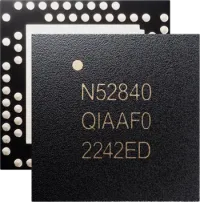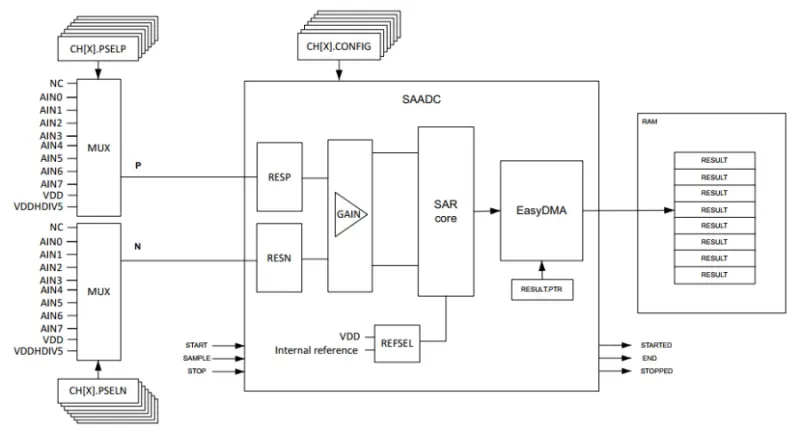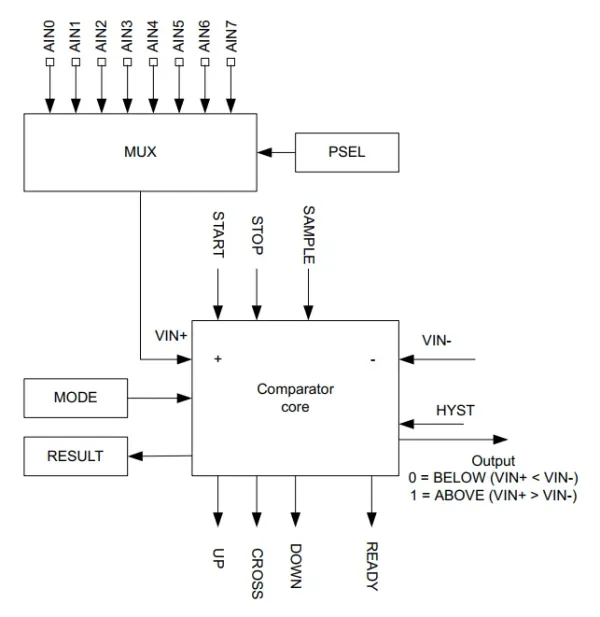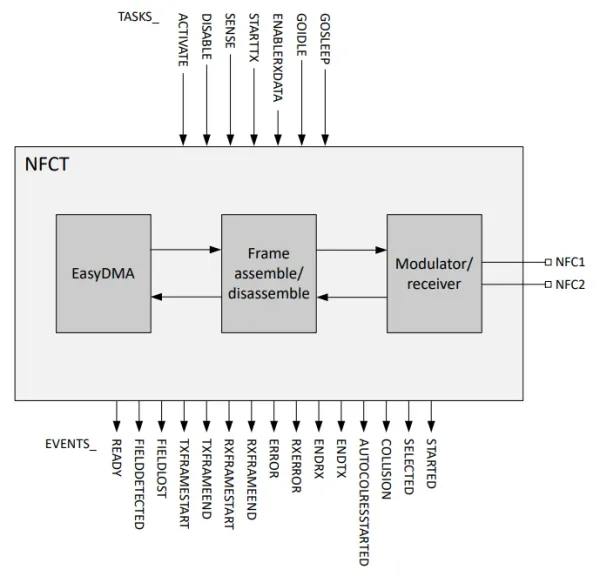nRF52
The nRF52 Series is a family of SoCs by Nordic Semiconductor. Two of their core features are Bluetooth and low-energy operation. They feature a 32-bit ARM Cortex-M4 CPU.
The nRF52 series supports the following wireless protocols with it’s RF radio:1
- Bluetooth 5.4
- Bluetooth LE
- Bluetooth mesh
- Thread
- Zigbee
- 802.15.4
- ANT
- 2.4GHz proprietary protocols
The nRF52840 is likely the most popular MCU in the series and is the most advanced variant in terms of features.1 It has a 64MHz Cortex-M4 CPU with FPU, 1MB flash and 256kB RAM.
The nRF52 series has good support for using the Zephyr framework to develop the firmware, as is officially backed by Nordic Semiconductor. Zephyr provides a RTOS, peripheral drivers and utility API. There are many project examples and guides available for using Zephyr with the nRF52.
GPIO Pins
This is a placeholder for the reference: fig-nrf52-gpio-port-pin-internal-architecture shows the internal architecture of a GPIO pin on the nRF52 series MCU.
GPIO Drive Strength
The GPIO pins can be configured in two different drive strengths, standard drive and high drive. This is a placeholder for the reference: tbl-nrf52-gpio-pin-current-limits shows the current limits for the GPIO pins when configured in standard drive and high drive. The current limits depend on the supply voltage and are also characterized for different output levels (e.g. 0.4 V is considered the max. for a logic low).
| Parameter | Description | Min | Typ | Max | Unit |
|---|---|---|---|---|---|
| Current at +0.4 V, output set low, standard drive, ≥ 1.7 | 1 | 2 | 4 | mA | |
| Current at +0.4 V, output set low, high drive, ≥ 2.7 V | 6 | 10 | 15 | mA | |
| Current at +0.4 V, output set low, high drive, ≥ 1.7 V | - | 3 | - | mA | |
| Current at -0.4 V, output set high, standard drive, ≥ 1.7 | 1 | 2 | 4 | mA | |
| Current at -0.4 V, output set high, high drive, ≥ 2.7 V | 6 | 9 | 14 | mA | |
| Current at -0.4 V, output set high, high drive, ≥ 1.7 V | - | 3 | - | mA |
When using the Zephyr framework for writing firmware, Zephyr provides nRF specific GPIO flags for controlling the drive strength. The drive strength is individually configurable for both a logic low and a logic high output. This is done with the following macros, which set the upper 8 bits of the gpio_dt_flags_t struct:3
NRF_GPIO_DRIVE_S0: Logic low, standard driveNRF_GPIO_DRIVE_H0: Logic low, high driveNRF_GPIO_DRIVE_S1: Logic high, standard driveNRF_GPIO_DRIVE_H1: Logic high, high drive
These flags are defined in the Zephyr repo under zephyr/include/zephyr/dt-bindings/gpio/nordic-nrf-gpio.h. For example, the following code is used to configure a GPIO pin with high drive in both directions using the gpio_pin_configure_dt() function:
#include <zephyr/drivers/gpio.h>#include <zephyr/dt-bindings/gpio/nordic-nrf-gpio.h> // Needed for the NRF_GPIO_DRIVE_H0H1 macro
// Update the PATH according to your .dts file(s)const struct gpio_dt_spec l_myGpio = GPIO_DT_SPEC_GET(DT_PATH(outputs, myGpio), gpios);
int main() { // Configure the GPIO pin as output, defaulting to low, with high drive in both directions. Other flags can be ORed in here too as needed. int intRc = gpio_pin_configure_dt(&l_myGpio, GPIO_OUTPUT_INACTIVE | NRF_GPIO_DRIVE_H0H1); __ASSERT_NO_MSG(intRc == 0);}Use the NFC Pins
By default, you won’t be able to use the two NFC pins (NFC1 and NFC2) on the MCU as GPIOs. To allow them to be used as GPIOs, add nfct-pins-as-gpios to your .dts file as shown:
&uicr { nfct-pins-as-gpios;};&uicr might already be present in your dts file with nfct-pins-as-gpios; applied. The old way of overriding the default NFC behaviour adding the Kconfig value CONFIG_NFCT_PINS_AS_GPIOS=y to your prj.conf. However this is now deprecated.
Successive Approximation ADC (SAADC)
The nRF52 series MCUs have a 12-bit successive approximation ADC peripheral called SAADC. This peripheral can be used to convert analogue voltages on the AIN0-AIN7 pins to digital values. It can be used in single ended mode or differential mode. This is a placeholder for the reference: fig-saadc-internal-block-diagram-nrf52 shows the internal block diagram of the SAADC peripheral.
The accumulator in the SAADC can be to find the average of multiple samples (oversampling). This is used to improve the SNR of the data. Oversampling can be configured with the OVERSAMPLE register. 2^OVERSAMPLE samples are averaged together before one result is written to memory. The DONE event is triggered for each input sample, and the RESULTDONE event is triggered once per averaged sample written to memory.
SAADC uses EasyDMA to write conversion results to RAM memory.
The SAADC peripheral cannot generate events when the converted value crosses a threshold. If you need this functionality, look at using the comparator peripheral (COMP) instead. The same analog input pin cannot be used for both SAADC and COMP peripherals at the same time.
Zephyr’s ADC driver can work with the SAADC peripheral. However, only basic functionality is provided by the Zephyr ADC API. For example, the Zephyr ADC API does not allow you to setup repeated sampling based on a timer connected with the DPPI/PPI. If you want more functionality than what the Zephyr ADC API provides, you can use the lower level nrfx SAADC driver.
Comparator (COMP)
The nRF52 series MCUs have a comparator peripheral called COMP. Much like discrete analogue comparator ICs, this peripheral can be used to compare one input voltage (VIN+) against another input voltage (VIN-), and can generate events (e.g. raise an interrupt) depending on the result (whether it is higher or lower than the other). VIN+ can be any of the analog input pins AIN0-AIN7. VIN- can be any of the analog input pins (differential mode) or from VREF, which in turn can be derived from VDD, AIN0-AIN7, or internal 1.2V, 1.8V or 2.4V references. It’s internal block diagram is shown in This is a placeholder for the reference: fig-comparator-diagram-nrf52.
Events can be generated from:2
UPonVIN->VIN+DOWNonVIN-<VIN+CROSSonVIN-crossingVIN+READYevent when core and internal reference are ready.
These built-in events make comparator great for simple analogue change detection. The ADC peripheral (SAADC) does not have these events, so if using an ADC instead you would need to continuously poll the ADC result and compare it using CPU time (which would both be higher power and a potential waste of CPU processing time).
The comparator peripheral has configurable hysteresis to prevent false events due to noise on the inputs. In differential mode, the hysteresis is set through the HYST register and can either be set to disabled or a fixed 50mV. In single ended mode, hysteresis can be set using VUP and VDOWN thresholds. The up and down thresholds in single ended mode offer much more flexibility than the HYST register available in differential mode.
The comparator peripheral have different speed modes, which also determine the power consumption. The speed modes are set using the MODE register. The different modes are:
- Low-power mode
- Normal mode
- High-speed mode
Near Field Communication Tag (NFCT)
The nRF52 series MCUs have a near field communication (NFC) tag peripheral called NFCT. This peripheral can be used to implement an NFC tag. It supports NFC-A listen mode operation at 13.56MHz and a bitrate of 106kbps.2
This is a placeholder for the reference: fig-nrf52-nfct-peripheral-block-diagram shows the internal block diagram of the NFCT peripheral.
The NFCT peripheral uses EasyDMA for the reading and writing of data packets to and from RAM.
As of May 2025, Nordic has the following firmware code examples relating to NRC:4
- NFC - Launch App: Launches an app on a polling smartphone.
- NFC - Text record: Exposes a text record to polling devices.
- NFC - Shell: Runs the shell interface with the NFC T4T ISO-DEP transport layer. It uses the NFC shell transport library.
- NFC - System OFF: Wakes the MCU up from System OFF mode when it detects an NFC field.
- NFC - Tag reader: Makes the MCU a tag reader which can interact with a NFC-A tag.
- NFC - TNEP poller: Uses the TNEP for polling device library to exchange data using an NFC polling device.
- NFC - TNEP tag: Uses the TNEP for tag device library to exchange data using NFC’s TNEP Protocol on an NFC Tag device.
- NFC - Writable NDEF message: Exposes an NDEF message that can be overwritten with any other NDEF message by an NFC device.
Internal RC Oscillator
To enable the internal RC oscillator, add the following to your prj.conf file:
CONFIG_CLOCK_CONTROL_NRF_K32SRC_RC=yBy default, CONFIG_CLOCK_CONTROL_NRF_K32SRC_RC_CALIBRATION=y is set which means the calibration parameters will be used to make the RC oscillator more accurate.
Footnotes
-
Nordic Semiconductor. Products / nRF52840 [product page]. Retrieved 2025-03-03, from https://www.nordicsemi.com/Products/nRF52840. ↩ ↩2 ↩3
-
Nordic Semiconductor (2024, Oct 1). nRF52840 - Product Specification - v1.11 [datasheet]. Retrieved 2025-03-03, from https://docs.nordicsemi.com/bundle/ps_nrf52840/page/keyfeatures_html5.html. ↩ ↩2 ↩3 ↩4 ↩5 ↩6 ↩7 ↩8
-
Zephyr Project (2025, Mar 3). Device Driver APIs > GPIO Driver APIs > nRF-specific GPIO Flags [documentation]. Retrieved 2025-03-03, from https://docs.zephyrproject.org/apidoc/latest/group__gpio__interface__nrf.html. ↩
-
Nordic Semiconductor (2025, May 7). nRF Connect SDK - latest > Samples > NFC samples [documentation]. Retrieved 2025-05-08, from https://docs.nordicsemi.com/bundle/ncs-latest/page/nrf/samples/nfc.html. ↩






